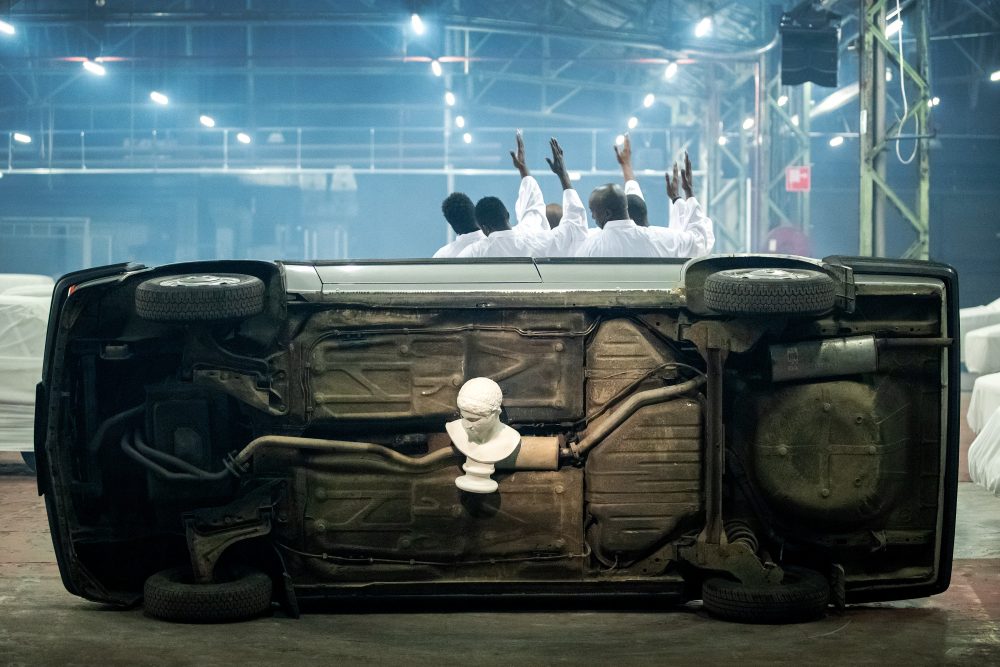La vita nuova

by Romeo Castellucci
Conceiving and direction: Romeo Castellucci
Text: Claudia Castellucci
Music: Scott Gibbons
With: Sedrick Amisi Matala, Abdoulay Djire,
Siegfried Eyidi Dikongo, Olivier Kalambayi Mutshita,
Mbaye Thiongane
Assistant director: Filippo Ferraresi
Stage sculptures and automations: Istvan Zimmermann and
Giovanna Amoroso - Plastikart studio
Costumes realization: Grazia Bagnaresi
Casting: Unusual Casting Bruxelles
Technical director: Paola Villani
Stage technician: Andrei Benchea
Light technician: Andrea Sanson
Sound technician: Nicola Ratti
Technical production staff: Eugenio Resta
with Carmen Castellucci, Daniele Magnani
Production supervisors: Benedetta Briglia, Giulia Colla
Production assistant: Caterina Soranzo
Promotion and distribution: Gilda Biasini
Administration: Simona Barducci, Elisa Bruno, Michela Medri
Economic consultant: Massimiliano Coli
Scene photographer: Stefan Glagla
Video shooting: Luca Mattei
Executive production: Societas
In coproduction with: Bozar, Center For Fine Arts (Brussel),
Kanal Centre Pompidou (Brussel), La Villette (Paris)
Opening on November the 28th, 2018
at Citroën Cultural Center, Place de l’Yser 7 - Brussels
The activity of Societas is supported by:
Minister of Cultur; Emilia Romagna Department; City council of Cesena
The sense of a beginning hovers in the air, here, in a large parking lot, where a handful of men has arranged a rendezvous. They are brothers, and they intend to inaugurate a new and better way of living together. Better, compared to what? Compared to the world they have cut themselves off from, their alienated roles, their salaries, politics and art. They no longer believe in these forms of social life.
The peace of dust reigns over the garage, or rather an acute melancholy created by the dust-covers draped over the many cars left here in storage. Screeching wheels echoing off sheets of metal seem to throw flares of light over the potentiality of the resting motors. Like beasts in a cage, these cars are the cells of the new seed that the brothers intend to bury. They have nothing phantasmagorical in their hands: no colours, no perfumes, no marvels for the senses. Nothing; or, better yet, they have this desolate parking lot fill of inert cars.
This is the starting point, the point of departure. One of them, more than any other, feels the responsibility to make an announcement. Speaking is not enough, it is the future that must be spoken of. What must happen? How must we behave, for it to happen? He and his brothers are the prophets of a new life, born simply out of their current human condition, which retains, no doubt, some forms typical of ancestral religions, but that expressly needs to invent other forms and ornaments, beginning with the poverty of reality. Reality is a perverted desert, whose indifference consists in the synchronic coexistence of all forms, in indistinctness and universal similarity, into which, the last to do so, art too has fallen. Even colours are accomplices in this wrongdoing, and so the prophets are dressed in white. Their revolt consists in speaking out and inventing new devices for daily life, in whatever context they eventually exist. This is no longer the time to return to one’s home base; to search for the ancestors’ roots; to rediscover Eden. These places do not exist anymore, and so they must be reinvented, realistically, using whatever is available; that is, here and now, the parking lot with the cars and the dust. The brothers have rebelled against the dictatorship of perceptions and habits, against the saturation of experience, the opaque space of their days, asphyxia, the loss of the senses. The prophets are not chasing after the void, nor the full: they confirm the now and the here. This is where the new life of the earth-less must arise, the life of those who construct new domestic and aesthetic hearths. Domestic aesthetics is the concrete dimension of daily life, that fuels and explains all of the senses. These brothers hate artists, because they say things, and do not do them. Above all their works: they say things, and do not do them. according to the prophets, artists have given themselves over to an art of total resemblance, even if they preach the opposite. The prophets set the art of living against living with art. They stand still and listen to biological growth, rather than standing in line at huge exhibitions.
Here, in this grey European, American, Chinese, Russian, Australian, Latin American parking lot, is where transmutations of objects and transvaluations of all values of art and humanity. Here and now, in the anywhere.
Henceforth the arts remained aloof from use (…) big technology was to reign, an easing, cool, bright democratic “luxury” for everybody, a reconstruction of the planet earth striving for the abolition of poverty, the hardship taken over by machines, centralised automation of the unessential, making leisure therefore possible. And great expression was to reign, decoration was to become profound again and to guarantee pure ornaments of solution to the voice of inner concern instead of the silence of outward care. (…)
Architecture, as the interior of the home space, continues to figure in an ever more humane construction space, which much be created today for the first time, as the anticipating expression of a “tat twam asi”, there you are. As an encounter with the self in the painted objects. You are this, that is “in your intimate essence, you are identical to the invisible substance of all things”, a formula attributed to Brahmin Aruni.
Ernst Bloch, The Spirit of Utopia, 1923